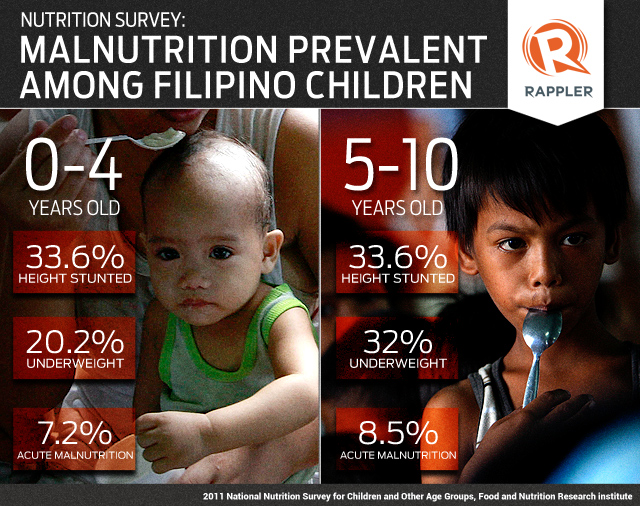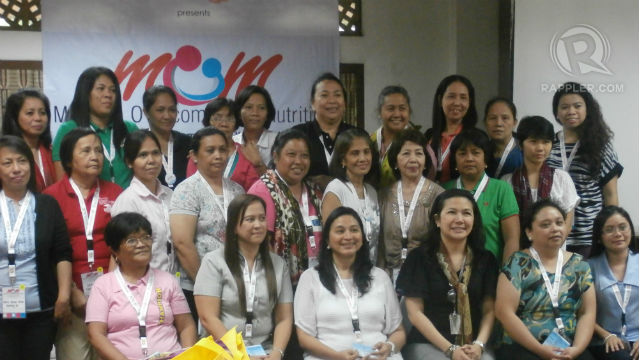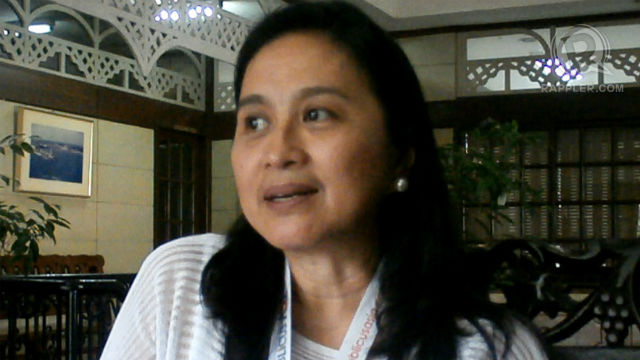SUMMARY
This is AI generated summarization, which may have errors. For context, always refer to the full article.

MANILA, Philippines – The results of the 2011 national nutrition survey of the Food and Nutrition Research Institute (FRNI) showed that malnutrition among Filipino children is still prevalent. The study’s findings, shared with the public recently, categorized children based on age, namely: 0 to 5 years old and 5 to 10 years old.
Results showed that 15.9% or two out of 10 children from 0 to 47 months old were born with low birth weight or were less than 5.5 lbs.
The results also showed that 20.2% of children in this category were underweight, while 33.6% were stunted or had lower heights for their age. 7.3% of the children suffered from acute malnutrition.
In the 5 to 10 years old category, results were much higher. 32% of children in this category were underweight while 33.6% had low heights for their age. The percentage of children suffering acute malnutrition was 8.5%.
‘Geographic advantage’
FNRI Senior Science Research Specialist Lilibeth Patalen-Dasco admitted that geographic location affected children’s health.
“Makikita mo na mas advantaged ang children sa Luzon over sa Visayas and Mindanao. Yung prevalences mataas doon sa Visayas and Mindanao regions…in terms of [those] underweight…over sa Luzon,” she said.
(Based on the results, you can see the children from Luzon are better off than those from the Visayas and Mindanao. The prevalences of underweight children in Visayas and Mindanao are higher than those over in Luzon.)
The survey showed that the provinces with the most number of malnourished children are those from Visayas and Mindanao.
In the 0 to 5 years old category, Western Visayas (19.3%), Bicol (18.6%), and SOCCSKSARGEN (18.2%) regions recorded the highest number of underweight children.
Meanwhile, NCR (6.2%), CALABARZON (5.9%) and the Ilocos (6.3%) regions recorded the highest number of overweight children in this age category.
Start young

Dasco explained that the reason the number of malnourished kids rose in the upper age category is because children’s development cannot be reversed.
“Once malnutrition occurs in the 0 to 47 months period…and it is not solved…children will carry this throughout their lives,” Dasco said in a mix of Filipino and English.
She maintained that battling malnutrition should start at infancy.
“Efforts should be poured to curb chronic malnutrition particularly in the first two years of life to prevent risk to delayed mental development, poor school performance and reduced intellectual capacity,” she added.
Dasco noted that efforts should also be focused on nutritionally-at-risk mothers as they are at greater risk of delivering infants with a low birth weight.
The role of mothers

On Thursday, July 11, non-governmental organizations, civil society groups and government institutions discussed possible solutions in battling malnutrition in Balay Kalinaw, UP Diliman.
The Mothers Overcoming Malnutrition (MOM) forum emphasized the role of mothers in sustaining the Filipino children’s nutritional needs.

WeDpro Chair Dr La Rainne Abad-Sarmiento said the mothers are at the forefront of the battle against malnutrition.
“Even if we say that we want shared responsibility, sila pa rin yung foremost. Their role is not only to provide and prepare the food properly but also…sila pa rin yung maaasahan mo to campaign even in their own villages,” Sarmiento added.
(Even if we say that we want shared responsibility, mothers are still the foremost fighters of malnutrition. Their role is not only to provide and prepare the food properly, but also more importantly, they’re the ones you can depend on to campaign in their own villages.)
She added that barangays should allot their development funds to more long-term health solutions rather than simply infrastructure.
“What is the most developmental? Is not nutrition very important? They can put it there. They can make use of that money. It depends on the priority of the barangay,” she said in a mix of Filipino and English.
Sarmiento noted that information dissemination and proper campaigning to mothers is crucial.
“The role is to hook the carers and the educators…If the barangays are well-informed then they can really set it as priority budget of the barangay,” she added.
Sen Cynthia Villar, who attended the event, said that the fight against malnutrition still has a long way to go.
“We still have a lot of work to do. And the more people or groups involved, the faster we can meet our targets, the more Filipinos we can save from poverty and hunger,” she added. -Rappler.com
Add a comment
How does this make you feel?
There are no comments yet. Add your comment to start the conversation.